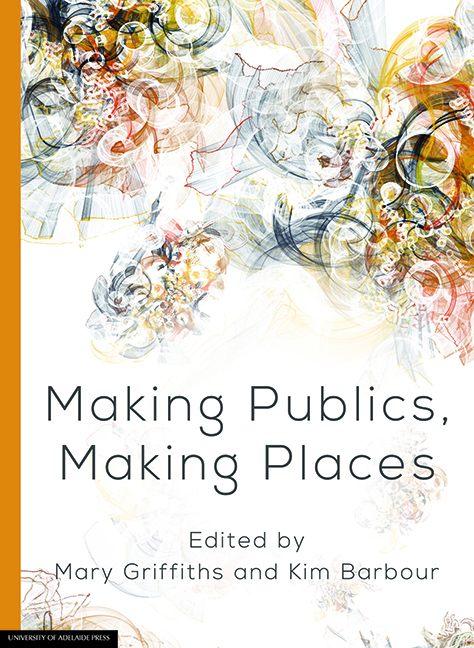Book contents
- Frontmatter
- Contents
- Preface
- Abstracts
- List of contributors
- 1 Making publics, making places
- 2 The elasticity of the public sphere: Expansion, contraction and ‘other’ media
- 3 ‘Imagine if our cities talked to us’: Questions about the making of ‘responsive’ places and urban publics
- 4 Picturing placelessness: Online graphic narratives and Australia's refugee detention centres
- 5 Reclaiming heritage for UNESCO: Discursive practices and community building in northern Italy
- 6 Find your Adelaide: Digital placemaking with Adelaide City Explorer
- 7 Chinese films and the sense of place: Beijing as ‘Thirdspace’ from In the Heat of the Sun to Mr Six
- 8 Social media and news media: Building new publics or fragmenting audiences?
- 9 The use of Chinese social media by foreign embassies: How ‘generative technologies’ are offering opportunities for modern diplomacy
- 10 An opinion leader and the making of a city on China's Sina Weibo
- 11 Public audiencing: Using Twitter to study audience engagement with characters and actors
- 12 Overcoming the tyranny of distance? High speed broadband and the significance of place
9 - The use of Chinese social media by foreign embassies: How ‘generative technologies’ are offering opportunities for modern diplomacy
Published online by Cambridge University Press: 28 July 2017
- Frontmatter
- Contents
- Preface
- Abstracts
- List of contributors
- 1 Making publics, making places
- 2 The elasticity of the public sphere: Expansion, contraction and ‘other’ media
- 3 ‘Imagine if our cities talked to us’: Questions about the making of ‘responsive’ places and urban publics
- 4 Picturing placelessness: Online graphic narratives and Australia's refugee detention centres
- 5 Reclaiming heritage for UNESCO: Discursive practices and community building in northern Italy
- 6 Find your Adelaide: Digital placemaking with Adelaide City Explorer
- 7 Chinese films and the sense of place: Beijing as ‘Thirdspace’ from In the Heat of the Sun to Mr Six
- 8 Social media and news media: Building new publics or fragmenting audiences?
- 9 The use of Chinese social media by foreign embassies: How ‘generative technologies’ are offering opportunities for modern diplomacy
- 10 An opinion leader and the making of a city on China's Sina Weibo
- 11 Public audiencing: Using Twitter to study audience engagement with characters and actors
- 12 Overcoming the tyranny of distance? High speed broadband and the significance of place
Summary
Social media platforms provide spaces for interaction and increased engagement, thus furthering the goals of public diplomacy. Due to the perceived ease with which social media can be accessed and the low cost in comparison with other methods, social media platforms are seen as attractive technology-based communication channels for many embassies and other organisations, particularly for those facing budget cuts and demands to increase engagement (Fisher 2013).
It is believed that social media provide the right channel to reach youth populations, which is one of the major goals of current public diplomacy efforts (Mershon 2012). For public diplomacy, it is equally important to listen to and understand young people's thoughts and aspirations, along with their information-seeking and other kinds of behaviours (Riordan 2004). In addition, social media provide the opportunity to reach the youth populations of other countries. In foreign embassies in China, for example, there are more than forty embassies that use the most popular Chinese social media platform — Weibo — to engage with the ‘online publics’ in China.
This chapter examines how ‘generative technologies’ are offering opportunities for modern diplomacy. Engagement and interactivity are what have been emphasised in using social media in public relation works. However, this chapter argues that interactivity is not necessarily linked to the success of the engagement with online publics via social media accounts. This chapter examines the interactivity of those embassies’ Weibo accounts by looking at two aspects: the number of comments or retweets that each post receives, and the number of negative and positive comments that each post receives.
According to my previous research, it is evident that Weibo can be employed effectively to engage with online communities, which is one of the goals of public diplomacy, but it was difficult to measure its real effects simply by looking at the data collected at that stage. In fact, one of the important phenomena which my research illustrates is that the number of followers does not equal the influence Weibo has on its followers — that is, the level of ‘conversational’ or informal communication on Weibo accounts does not indicate the success of e-diplomacy.
- Type
- Chapter
- Information
- Making Publics, Making Places , pp. 145 - 162Publisher: The University of Adelaide PressPrint publication year: 2016



